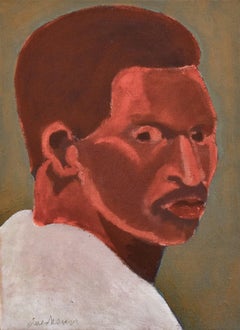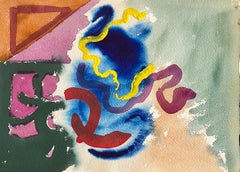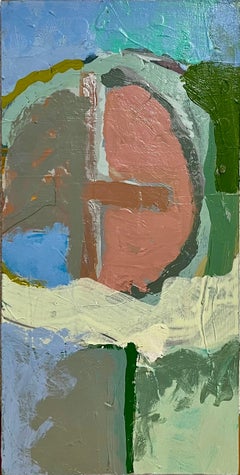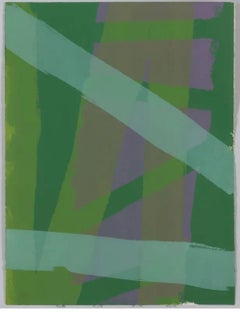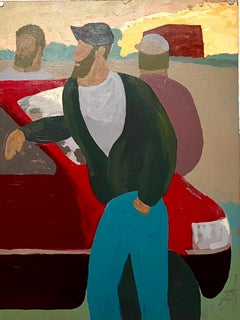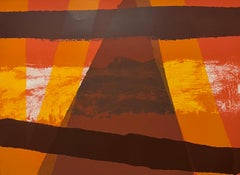Edward Avedisian Art
to
15
15
8
8
6
5
1
Portrait of Dave Winfield, American Major League Baseball Right Fielder
By Edward Avedisian
Located in Hudson, NY
Portrait of Dave Winfield
Edward Avedisian
20 x 14 inches, acrylic on stretched canvas
Armenian-American artist, Avedisian was best known for his work made in New York City during the 1960s: brilliantly colored, boldly composed canvases that combined Minimalism’s rigor, Pop’s exuberance and the saturated tones of Color Field painting. He was largely recognized for a series of Beach Ball paintings that emerged in the early 1960's and into the later 1960's the artist began painting larger horizontal paintings, featuring vertically intersecting beacon-like stripes that highlighted characteristics from both the Post-Painterly and Color Field movements.
In this portrait, Avedisian using his signature use of color, combining bright rusty reds and oranges against a metallic green gold backdrop.
A major work from Avedesian's color-stripe series was featured on the cover of Artforum's January 1969 issue (pictured here). Also pictured are photographs of the artist c. 1970 in his studio in New York City and catalog pages from Avedisian's inclusion in the American Painting Now Expo at the Institute of Contemporary Art in Boston, MA in Dec 1967 - Jan 1968. The exhibition, organized by art critic Alan Solomon, featured one of Avedisian's signature Beach Ball paintings alongside large works by Robert Motherwell and Jim Rosenquist.
About the subject:
Dave Winifield is American former Major League Baseball right fielder born in 1951 and who played for six teams (San Diego Padres, New York Yankees, California Angels, Toronto Blue Jays, Minnesota Twins, and Cleveland Indians) during his 22 year long career. He had the winning hit in the 1992 World Series with the Blue Jays over the Atlanta Braves. Winfield retired in 1996 and was elected to the Baseball Hall of Fame in 2001, in his first year of eligibility.
About the Artist:
In the 1960’s, Edward Avedisian was one of the youngest of those luminaries producing a grand new abstract painting. Shown first at Ivan Karp and Dick Bellamy’s Hansa Gallery and then at Robert Elkon, Avedisian’s insouciant mix of pop playfulness, color field cool and high formalist style put his art in a unique, and at the time generously rewarded, position. Paintings made it onto the cover of Artforum, were purchased by all the major museums, were among the few abstract works shown as representative of America’s post-war achievement at Expo 67 in Montreal and comprised a cornerstone in histories of the period written by Barbara Rose, among others. The artist was largely influenced by his Color-Field predecessors, Mark Rothko and Barnett Newman. Throughout the 1960's and into the mid 1970's the artist was celebrated in the Manhattan art scene, contributing to the Post-Painterly Abstraction movements with contemporaries Helen Frankenthaler, Andy Warhol, Jules Olitski, and Larry Poons.
Museum Collections:
Albright-Knox Art Gallery, Buffalo, New York
Brooklyn Museum, New York
Chrysler Art Museum, Norfolk, Virginia
Denver Art Museum, Colorado
Flint Institute of Arts, Michigan
Jack S. Blanton Museum of Art, Austin, Texas
The Larry Aldrich Museum, Ridgefield, Connecticut
Metropolitan Museum of Art, New York
Minneapolis Institute of Arts
Minneapolis Society of Fine Arts
Neuberger Museum of Art, State University of New York, Purchase
Los Angeles County Museum, California
Neuberger Museum, SUNY, Purchase, New York
Parrish Art Museum, Water Mill, New York
Solomon R. Guggenheim Museum
*above description text is supported by Alexandra C. Anderson's article on Edward Avedesian in Artforum's January 1969 issue.
NY Times Obituary, published Aug 23, 2007 by Roberta Smith:
Mr. Avedisian was best known for his work in the 1960s: brilliantly colored, boldly composed canvases that combined Minimalism’s rigor, Pop’s exuberance and the saturated tones of Color Field painting.
A frequent motif was a cluster of bright seedlike orbs corralled at the center of a vibrant monochrome field by larger rings of color, creating an image that could resemble a buoyant cross-section of some unknown fruit.
Mr. Avedisian was born in Lowell, Mass., in 1936 and studied art at the Boston Museum School. By the late 1950s he was living in New York, part of a generation of promising young painters that included Frank Stella, Larry Poons and Darby Bannard.
From 1958 to 1963 Mr. Avedisian had six solo shows in New York galleries, including two at the Robert Elkon Gallery, where he continued to show almost every year until 1975. By the early 1960s Mr. Avedisian was a rising star. During that decade, his work appeared on the cover of Artforum, in “The Responsive Eye” exhibition of Op Art at the Museum of Modern Art and in four annuals at the Whitney Museum of American Art. His paintings were widely sought by collectors and acquired by major museums in New York and elsewhere.
In the mid-1970s Mr. Avedisian moved to Hudson and became less visible. His paintings soon began shifting toward representation; he took to calling his abstract paintings “a period style.” But he continued to be well served by his feeling for color, scale and surface. His landscapes described his surroundings in blunt, flat shapes and singing hues reminiscent of those of Marsden Hartley and Paula Modersohn...
Category
1980s Contemporary Edward Avedisian Art
Materials
Canvas, Acrylic
Mod Abstract Expressionist Modernist Edward Avedisian Color Field Art Gouache
By Edward Avedisian
Located in Surfside, FL
Edward Avedisian Gouache Watercolor Abstract Painting on Arches paper. (notebook cover not included)
Unsigned, (bears name verso in pencil.)
Dimensions: 10" X 14"
Late 1970s, early ...
Category
1970s Abstract Expressionist Edward Avedisian Art
Materials
Watercolor, Gouache
Mod Abstract Expressionist Modernist Oil Painting Edward Avedisian Color Forms
By Edward Avedisian
Located in Surfside, FL
Edward Avedisian ( 1936-2007 )
15 X 8.5
Oil paint on wood panel
This is not signed on front. It bears his name verso.
Provenance: Hudson, N.Y. estate of noted Art Collector Albert B...
Category
1960s Abstract Expressionist Edward Avedisian Art
Materials
Oil, Wood Panel
Mod Abstract Expressionist Modernist Oil Painting Edward Avedisian Color Circles
By Edward Avedisian
Located in Surfside, FL
Edward Avedisian ( 1936-2007 )
17.5 X 8.75
Oil paint on wood panel
This is not signed on front. It bears his name verso.
Provenance: Hudson, N.Y. estate of noted Art Collector Alber...
Category
1960s Abstract Expressionist Edward Avedisian Art
Materials
Oil, Wood Panel
Mod Abstract Expressionist Modernist Lithograph Edward Avedisian Color Field Art
By Edward Avedisian
Located in Surfside, FL
Edward Avedisian (1936-2007)
Green Gold, 1969
Lithograph in color on Arches wove paper.
Hand signed, dated and numbered in pencil.
Edition 100
Dimensions:
22.25 inches X 30.25 inch...
Category
1960s Abstract Expressionist Edward Avedisian Art
Materials
Lithograph
Large Hudson River Figurative Modernist Landscape Oil Painting Edward Avedisian
By Edward Avedisian
Located in Surfside, FL
Edward Avedisian ( 1936-2007 )
Gouache or oil on paper, 3 guys around a car,
hand signed in paint lower left,
Measures 30"x 22.5"
Edward Avedisian (June 15, 1936, Lowell, Massachusetts – August 17, 2007, Philmont, New York) was an American abstract painter who came into prominence during the 1960s. His work was initially associated with Color field painting and in the late 1960s with Lyrical Abstraction and Abstract Expressionism.
He studied art at the School of the Museum of Fine Arts, Boston. By the late 1950s he moved to New York City. Between 1958 and 1963 Avedisian had six solo shows in New York. In 1958 he initially showed at the Hansa Gallery, then he had three shows at the Tibor de Nagy Gallery and in 1962 and 1963 at the Robert Elkon Gallery. He continued to show at the Robert Elkon Gallery almost every year until 1975.
During the 1960s his work was broadly visible in the contemporary art world. He joined the dynamic art scene in Greenwich Village, frequenting the Cedar Tavern on Tenth Street, associating with the critic Clement Greenberg, and joining a new generation of abstract artists, such as Darby Bannard, Kenneth Noland, Jules Olitski, and Larry Poons.
Avedisian was among the leading figures to emerge in the New York art world during the 1960s. An artist who mixed the hot colors of Pop Art with the cool, more analytical qualities of Color Field painting, he was instrumental in the exploration of new abstract methods to examine the primacy of optical experience.
One of his paintings was appeared on the cover of Artforum, in 1969, his work was included in the 1965 Op Art The Responsive Eye exhibition at the Museum of Modern Art and in four annuals at the Whitney Museum of American Art. His paintings were widely sought after by collectors and acquired by major museums in New York and elsewhere. He has been exhibited in prominent galleries, such as the Anita Shapolsky Gallery and the Berry Campbell Gallery in New York City. Edward Avedisian was known for his brightly colored, boldly composed canvases that combined Minimalism's rigor, Pop art exuberance and the saturated tones of Color Field painting.
Roberta Smith of the NYT writes of Avedesian: "Edward Avedisian helped establish the hotly colored, but emotionally cool, abstract painting that succeeded Abstract Expressionism in the early 1960s. This young luminary harnessed elements of minimalism, pop, and color field painting to create prominent works of epic proportions that energized the New York art scene of the time." In 1996 Avedisian showed his paintings from the 1960s at the Mitchell Algus Gallery, then in SoHo. His last show, dominated by recent landscapes, was in 2003 at the Algus gallery, now in Chelsea.
Selected Exhibitions:
Op Art: The Responsive Eye, at the Museum of Modern Art,
Whitney Museum’s Young America 1965
Expo 67, held in Montreal, Canada.
Six Painters (along with Darby Bannard, Dan Christensen, Ron Davis...
Category
20th Century American Modern Edward Avedisian Art
Materials
Oil, Gouache, Archival Paper
Mod Abstract Expressionist Modernist Oil Painting Dog Drawing Edward Avedisian
By Edward Avedisian
Located in Surfside, FL
Edward Avedisian ( 1936-2007 )
7.5 X 5.75
Oil paint on wood panel
This is not signed on front. It bears his name verso.
Provenance: Hudson, N.Y. estate of noted Art Collector Albert...
Category
1960s Abstract Expressionist Edward Avedisian Art
Materials
Oil, Wood Panel, Graphite
Mod Abstract Expressionist Modernist Oil Painting Edward Avedisian Color Forms
By Edward Avedisian
Located in Surfside, FL
Edward Avedisian ( 1936-2007 )
17.5 X 8.75
Oil paint on wood panel
This is not signed on front. It bears his name verso.
Provenance: Hudson, N.Y. estate of noted Art Collector Alber...
Category
1960s Abstract Expressionist Edward Avedisian Art
Materials
Oil, Wood Panel
Mod Abstract Expressionist Modernist Edward Avedisian Color Field Oil Painting
By Edward Avedisian
Located in Surfside, FL
Edward Avedisian
Unsigned, (bears name signed verso in pencil.)
Dimensions: 15" X 15" (round tondo)
Circa late 1970s
This is a mod, brutalist portrait of a man
Edward Avedisian (J...
Category
1970s Abstract Expressionist Edward Avedisian Art
Materials
Oil, Board
Mod Abstract Expressionist Modernist Lithograph Edward Avedisian Color Field Art
By Edward Avedisian
Located in Surfside, FL
Edward Avedisian (1936-2007)
Cleo, Fur Queen, 1969
Lithograph in color on Arches wove paper.
Hand signed, dated and numbered in pencil.
Edition 100
Dimensions:
22.25 inches X 30.25...
Category
1960s Abstract Expressionist Edward Avedisian Art
Materials
Lithograph
Mod Abstract Expressionist Modernist Edward Avedisian Color Field Art Gouache
By Edward Avedisian
Located in Surfside, FL
Edward Avedisian Gouache Watercolor Abstract Painting on Arches paper. (notebook cover not included)
Unsigned, (bears name verso in pencil.)
Dimensions: 10" X 14"
Late 1970s, early 1...
Category
1970s Abstract Expressionist Edward Avedisian Art
Materials
Watercolor, Gouache
Mod Abstract Expressionist Modernist Oil Painting Edward Avedisian Color Figure
By Edward Avedisian
Located in Surfside, FL
Edward Avedisian ( 1936-2007 )
8 X 9
Oil paint on wood plank panel with gold and purple figure
This is not signed on front. It bears his name verso.
Provenance: Hudson, N.Y. estate of noted Art Collector Albert Burnette Roberts (1932-2021)
Edward Avedisian (June 15, 1936, Lowell, Massachusetts – August 17, 2007, Philmont, New York) was an American abstract painter who came into prominence during the 1960s. His work was initially associated with Color field painting and in the late 1960s with Lyrical Abstraction and Abstract Expressionism.
He studied art at the School of the Museum of Fine Arts, Boston. By the late 1950s he moved to New York City. Between 1958 and 1963 Avedisian had six solo shows in New York. In 1958 he initially showed at the Hansa Gallery, then he had three shows at the Tibor de Nagy Gallery and in 1962 and 1963 at the Robert Elkon Gallery. He continued to show at the Robert Elkon Gallery almost every year until 1975.
During the 1960s his work was broadly visible in the contemporary art world. He joined the dynamic art scene in Greenwich Village, frequenting the Cedar Tavern on Tenth Street, associating with the critic Clement Greenberg, and joining a new generation of abstract artists, such as Darby Bannard, Kenneth Noland, Jules Olitski, and Larry Poons.
Avedisian was among the leading figures to emerge in the New York art world during the 1960s. An artist who mixed the hot colors of Pop Art with the cool, more analytical qualities of Color Field painting, he was instrumental in the exploration of new abstract methods to examine the primacy of optical experience.
One of his paintings was appeared on the cover of Artforum, in 1969, his work was included in the 1965 Op Art The Responsive Eye exhibition at the Museum of Modern Art and in four annuals at the Whitney Museum of American Art. His paintings were widely sought after by collectors and acquired by major museums in New York and elsewhere. He has been exhibited in prominent galleries, such as the Anita Shapolsky Gallery and the Berry Campbell...
Category
1960s Abstract Expressionist Edward Avedisian Art
Materials
Oil, Wood Panel
Mod Abstract Expressionist Modernist Edward Avedisian Color Field Art Gouache
By Edward Avedisian
Located in Surfside, FL
Edward Avedisian Gouache Watercolor Abstract Painting on Arches paper. (notebook cover not included)
Unsigned, (bears name verso in pencil.)
Dimensions: 10" X 14"
Late 1970s, early 1...
Category
1970s Abstract Expressionist Edward Avedisian Art
Materials
Watercolor, Gouache
Mod Abstract Expressionist Modernist Edward Avedisian Color Field Art Gouache
By Edward Avedisian
Located in Surfside, FL
Edward Avedisian Gouache Watercolor Abstract Painting on Arches paper. (notebook cover not included)
Unsigned, (bears name verso in pencil.)
Dimensions: 10" X 14"
Late 1970s, early 1...
Category
1970s Abstract Expressionist Edward Avedisian Art
Materials
Watercolor, Gouache
Mod Abstract Expressionist Modernist Oil Painting Edward Avedisian Color Circles
By Edward Avedisian
Located in Surfside, FL
Edward Avedisian ( 1936-2007 )
12 X 8.5
Oil paint on wood panel
This is not signed on front. It bears his name verso.
Provenance: Hudson, N.Y. estate of noted Art Collector Albert B...
Category
1960s Abstract Expressionist Edward Avedisian Art
Materials
Oil, Wood Panel
Related Items
Original-Impasto-Moonlit Dahlias-Jardin d'Hiver-British Awarded Artist-Gold leaf
Located in London, GB
Jardin d'Hiver Series is Shizico Yi's latest collection, created in her winter studio while longing for the summer left behind. Reflecting on the vibrant days spent painting en plein...
Category
2010s Abstract Impressionist Edward Avedisian Art
Materials
Gold Leaf
On Hold
$863
H 15.75 in W 11.82 in D 0.2 in
Originals-Magic Bell Triptych-British Awarded Artist-After Monet-Impressionism
Located in London, GB
To Shizico Yi a triptych is a visual prayers; it embodies a meditative journeylike the form of meditation.
The repetition of motifs within the triptych serves as a method to revisit...
Category
2010s Abstract Impressionist Edward Avedisian Art
Materials
Gesso, Canvas, Oil, Acrylic, Wood Panel
$1,880
H 15.75 in W 35.44 in D 0.12 in
Octavio Paz Suite: Nocturne VI
By Robert Motherwell
Located in London, GB
Lithograph and chine appliqué
64.5 x 54 cms (25 3/8 x 21 1/4 ins)
Edition 50
Paper: Arches paper; Japanese Gampi handmade paper
Other Collaborators: Image transferred from Mylar to...
Category
1980s Abstract Expressionist Edward Avedisian Art
Materials
Handmade Paper, Color, Lithograph
Original-Sunset Song-British Awarded Artist-Impressionism-Plein Air evening oil
Located in London, GB
Sunset Song Series stands as one of the most iconic works featured in the upcoming Summer Exhibition UK, 2025—a rare and luminous collection of latest artworks we’re thrilled to pres...
Category
2010s Abstract Impressionist Edward Avedisian Art
Materials
Gesso, Canvas, Oil, Acrylic, Wood Panel
$780 Sale Price
20% Off
H 15.75 in W 11.82 in D 0.2 in
Original-Sunset Song II-British Awarded Artist-Impressionism-Plein Air evening
Located in London, GB
Sunset Song Series stands as one of the most iconic works featured in the upcoming Summer Exhibition UK, 2025—a rare and luminous collection of latest artworks we’re thrilled to pres...
Category
2010s Abstract Impressionist Edward Avedisian Art
Materials
Gesso, Canvas, Oil, Acrylic, Wood Panel
$880 Sale Price
20% Off
H 15.75 in W 11.82 in D 0.2 in
Woman and Child in the Woods - Midcentury Abstracted Landscape in Oil on Canvas
Located in Soquel, CA
Woman and Child in the Woods - Midcentury Abstracted Landscape in Oil on Canvas
Dramatic abstracted painting of a woman holding a child in the woods by Maley (20th Century). This pi...
Category
1970s American Modern Edward Avedisian Art
Materials
Canvas, Oil, Stretcher Bars
$2,500
H 26.5 in W 21 in D 1 in
Original-Impasto-Jardin d'Hiver-Dahlia over Climbing Rose-British Awarded Artist
Located in London, GB
Jardin d'Hiver Series is Shizico Yi's latest collection, created in her winter studio while longing for the summer left behind. Reflecting on the vibrant days spent painting en plein...
Category
2010s Abstract Impressionist Edward Avedisian Art
Materials
Gesso, Canvas, Oil, Acrylic, Wood Panel
$657 Sale Price
20% Off
H 15.75 in W 11.82 in D 0.2 in
Mid Century Palace of Fine Arts, San Francisco Landscape
Located in Soquel, CA
Palace of Fine Arts, San Francisco by Garrett Price (American, 1896-1979). Signed "Garrett" lower right. Unframed. Image size, 11.75"H x 15.25"W. G...
Category
1950s American Modern Edward Avedisian Art
Materials
Paper, Watercolor
$760 Sale Price
20% Off
H 12 in W 16 in D 1 in
Polly Dutton, Spring Song, Semi Abstract Art, Original Oil Painting
Located in Deddington, GB
Spring Song by Polly Dutton [2020]
Original
Oil on birchwood panel
Image size: H:30 cm x W:30 cm
Complete Size of Unframed Work: H:30 cm x W:30 cm x D:2cm...
Category
21st Century and Contemporary Abstract Edward Avedisian Art
Materials
Oil, Wood Panel
$689
H 11.82 in W 11.82 in D 0.79 in
Original Set Primary Blue series-Summer Cat-White Butterfly-BritishAward Artist
Located in London, GB
-In light of new tariffs, we’ve applied a 20% discount off the market price of this piece to support our collectors in facing potential added costs. At the gallery, we work closely w...
Category
2010s Abstract Expressionist Edward Avedisian Art
Materials
Silver
$2,535
H 23.63 in W 31.5 in D 0.2 in
The Darker Palette print, Hand signed twice and inscribed by Helen Frankenthaler
By Helen Frankenthaler
Located in New York, NY
Helen Frankenthaler (after)
Frankenthaler: The Darker Palette (autographed and inscribed), 1998
Offset Lithograph print
42 × 35 in
hand signed "Frankenthaler" lower left; inscribed a...
Category
1990s Abstract Expressionist Edward Avedisian Art
Materials
Offset, Lithograph
Adolph Gottlieb, rare exhibition print for Guild Hall in Easthampton, NY, Framed
By Adolph Gottlieb
Located in New York, NY
Adolph Gottlieb
Guild Hall is for Everyone, 1970
Rare Abstract Expressionist Offset Lithograph poster
Vintage metal Frame included
Rare vintage, limited edition, offset lithograph ...
Category
1970s Abstract Expressionist Edward Avedisian Art
Materials
Lithograph, Offset
$640 Sale Price
20% Off
H 34.5 in W 25.75 in D 0.5 in
Previously Available Items
Mod Abstract Expressionist Modernist Edward Avedisian Color Field Art Gouache
By Edward Avedisian
Located in Surfside, FL
Edward Avedisian Gouache Watercolor Abstract Painting on Arches paper. (notebook cover not included)
Unsigned, (bears name verso in pencil.)
Dimensions: 10" X 14"
Inscribed: "Sept 79...
Category
1970s Abstract Expressionist Edward Avedisian Art
Materials
Watercolor, Gouache
Mod Abstract Expressionist Modernist Lithograph Edward Avedisian Color Field Art
By Edward Avedisian
Located in Surfside, FL
Edward Avedisian (1936-2007)
Cleo, Fur Queen, 1969
Lithograph in color on Arches wove paper.
Hand signed, dated and numbered in pencil.
Edition 100
Dimensions:
22.25 inches X 30.25...
Category
1960s Abstract Expressionist Edward Avedisian Art
Materials
Lithograph
Mod Abstract Expressionist Modernist Oil Painting Edward Avedisian Biomorphic
By Edward Avedisian
Located in Surfside, FL
Edward Avedisian ( 1936-2007 )
7 X 13
Oil paint on wood panel with pink, red and green abstract.
This is not signed on front. It bears his name verso.
Provenance: Hudson, N.Y. estate of noted Art Collector Albert Burnette Roberts (1932-2021)
Edward Avedisian (June 15, 1936, Lowell, Massachusetts – August 17, 2007, Philmont, New York) was an American abstract painter who came into prominence during the 1960s. His work was initially associated with Color field painting and in the late 1960s with Lyrical Abstraction and Abstract Expressionism.
He studied art at the School of the Museum of Fine Arts, Boston. By the late 1950s he moved to New York City. Between 1958 and 1963 Avedisian had six solo shows in New York. In 1958 he initially showed at the Hansa Gallery, then he had three shows at the Tibor de Nagy Gallery and in 1962 and 1963 at the Robert Elkon Gallery. He continued to show at the Robert Elkon Gallery almost every year until 1975.
During the 1960s his work was broadly visible in the contemporary art world. He joined the dynamic art scene in Greenwich Village, frequenting the Cedar Tavern on Tenth Street, associating with the critic Clement Greenberg, and joining a new generation of abstract artists, such as Darby Bannard, Kenneth Noland, Jules Olitski, and Larry Poons.
Avedisian was among the leading figures to emerge in the New York art world during the 1960s. An artist who mixed the hot colors of Pop Art with the cool, more analytical qualities of Color Field painting, he was instrumental in the exploration of new abstract methods to examine the primacy of optical experience.
One of his paintings was appeared on the cover of Artforum, in 1969, his work was included in the 1965 Op Art The Responsive Eye exhibition at the Museum of Modern Art and in four annuals at the Whitney Museum of American Art. His paintings were widely sought after by collectors and acquired by major museums in New York and elsewhere. He has been exhibited in prominent galleries, such as the Anita Shapolsky Gallery and the Berry Campbell...
Category
1960s Abstract Expressionist Edward Avedisian Art
Materials
Oil, Wood Panel
Mod Abstract Expressionist Modernist Oil Painting Edward Avedisian Color Circles
By Edward Avedisian
Located in Surfside, FL
Edward Avedisian ( 1936-2007 )
21.5 X 22
This is not signed on front. It bears his name verso.
Provenance: Hudson, N.Y. estate of noted Art Collector Albert Burnette Roberts (1932-2021)
Edward Avedisian (June 15, 1936, Lowell, Massachusetts – August 17, 2007, Philmont, New York) was an American abstract painter who came into prominence during the 1960s. His work was initially associated with Color field painting and in the late 1960s with Lyrical Abstraction and Abstract Expressionism.
He studied art at the School of the Museum of Fine Arts, Boston. By the late 1950s he moved to New York City. Between 1958 and 1963 Avedisian had six solo shows in New York. In 1958 he initially showed at the Hansa Gallery, then he had three shows at the Tibor de Nagy Gallery and in 1962 and 1963 at the Robert Elkon Gallery. He continued to show at the Robert Elkon Gallery almost every year until 1975.
During the 1960s his work was broadly visible in the contemporary art world. He joined the dynamic art scene in Greenwich Village, frequenting the Cedar Tavern on Tenth Street, associating with the critic Clement Greenberg, and joining a new generation of abstract artists, such as Darby Bannard, Kenneth Noland, Jules Olitski, and Larry Poons.
Avedisian was among the leading figures to emerge in the New York art world during the 1960s. An artist who mixed the hot colors of Pop Art with the cool, more analytical qualities of Color Field painting, he was instrumental in the exploration of new abstract methods to examine the primacy of optical experience.
One of his paintings was appeared on the cover of Artforum, in 1969, his work was included in the 1965 Op Art The Responsive Eye exhibition at the Museum of Modern Art and in four annuals at the Whitney Museum of American Art. His paintings were widely sought after by collectors and acquired by major museums in New York and elsewhere. He has been exhibited in prominent galleries, such as the Anita Shapolsky Gallery and the Berry Campbell Gallery in New York City. Edward Avedisian was known for his brightly colored, boldly composed canvases that combined Minimalism's rigor, Pop art exuberance and the saturated tones of Color Field painting.
Roberta Smith of the NYT writes of Avedesian: "Edward Avedisian helped establish the hotly colored, but emotionally cool, abstract painting that succeeded Abstract Expressionism in the early 1960s. This young luminary harnessed elements of minimalism, pop, and color field painting to create prominent works of epic proportions that energized the New York art scene of the time." In 1996 Avedisian showed his paintings from the 1960s at the Mitchell Algus Gallery, then in SoHo. His last show, dominated by recent landscapes, was in 2003 at the Algus gallery, now in Chelsea.
Selected Exhibitions:
Op Art: The Responsive Eye, at the Museum of Modern Art,
Whitney Museum’s Young America 1965
Expo 67, held in Montreal, Canada.
Six Painters (along with Darby Bannard, Dan Christensen, Ron Davis...
Category
1960s Abstract Expressionist Edward Avedisian Art
Materials
Oil, Canvas
Hudson River Flats, Abstract Expressionist Landscape Oil Painting
By Edward Avedisian
Located in Surfside, FL
Edward Avedisian (June 15, 1936, Lowell, Massachusetts – August 17, 2007, Philmont, New York) was an American abstract painter who came into prominence during the 1960s. His work was...
Category
20th Century Abstract Expressionist Edward Avedisian Art
Materials
Cotton Canvas, Oil
Untitled 009 (1970s Abstract Watercolor Painting in Neon Green and Red)
By Edward Avedisian
Located in Hudson, NY
9 x 11.5 inches, watercolor on paper
15 x 15.5 x 1 inches, custom frame, black wood molding, 8 ply white mat
Vertical striped watercolor painting on paper with a playful color combi...
Category
1970s Abstract Expressionist Edward Avedisian Art
Materials
Watercolor, Archival Paper
H 15 in W 15.5 in D 1 in
Lost at Dawn
By Edward Avedisian
Located in Hudson, NY
acrylic on canvas
Category
20th Century Edward Avedisian Art
Materials
Acrylic, Canvas
Untitled 016
By Edward Avedisian
Located in Hudson, NY
acrylic on canvas
Category
1960s Abstract Edward Avedisian Art
Materials
Acrylic, Canvas
Untitled 015
By Edward Avedisian
Located in Hudson, NY
acrylic on canvas
Category
1960s Abstract Edward Avedisian Art
Materials
Acrylic, Canvas
Green and Gold Beach Ball
By Edward Avedisian
Located in Hudson, NY
Category
Edward Avedisian Art
Materials
Acrylic, Canvas
Edward Avedisian art for sale on 1stDibs.
Find a wide variety of authentic Edward Avedisian art available for sale on 1stDibs. If you’re browsing the collection of art to introduce a pop of color in a neutral corner of your living room or bedroom, you can find work that includes elements of red and other colors. You can also browse by medium to find art by Edward Avedisian in paint, oil paint, panel and more. Much of the original work by this artist or collective was created during the 20th century and is mostly associated with the abstract style. Not every interior allows for large Edward Avedisian art, so small editions measuring 6 inches across are available. Customers who are interested in this artist might also find the work of John von Wicht, Sylvia Rutkoff, and Rebecca Allan.
